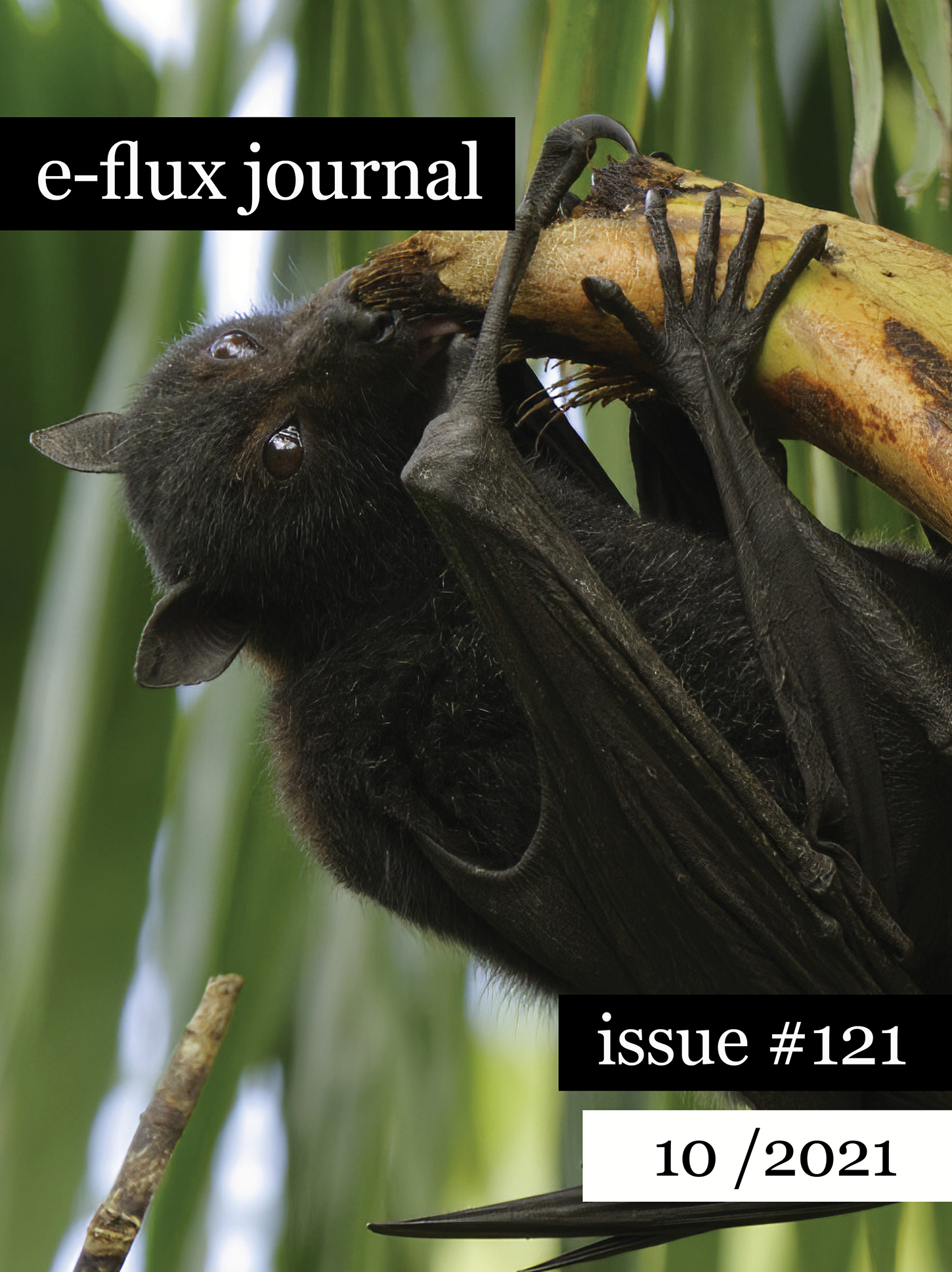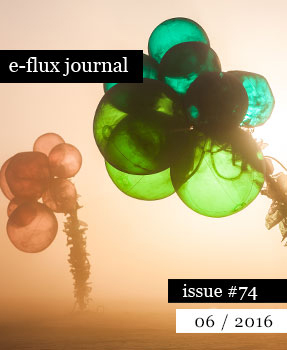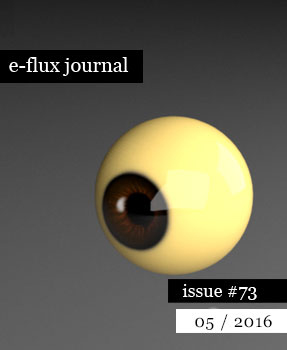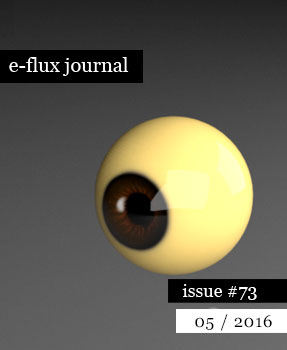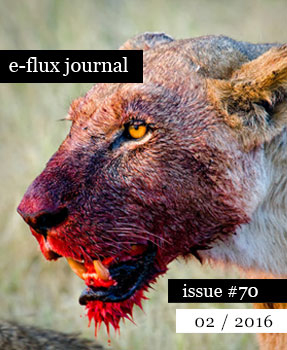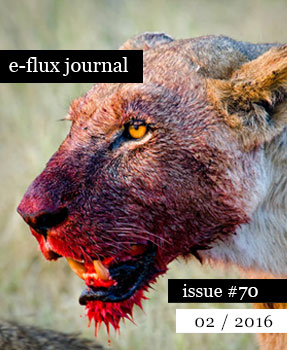e-flux journal issue 121
with Hito Steyerl, Department of Decentralization, and GPT-3; Elizabeth A. Povinelli; Stefano Harney, Fred Moten, Sandra Ruiz, and Hypatia Vourloumis; Tam Donner; Deborah Bird Rose; Andreas Petrossiants; and Alexander R. Galloway and Bernard Dionysius Geoghegan
It is now October, when the veils between worlds become thin. In this issue, there are human worlds and more-than-human worlds, and the university worlds, world wars, and art worlds that cross between them. Tam Donner plumbs the world we live in. Have you heard the one where universities give out honorary hoods to painters and warmongers alike? Take a look at the class pictures. Andreas Petrossiants follows the lead of Mount Etna, Europe’s oldest active volcano, where Pasolini may have seen a stage—or a screen—on which to feature the volcano’s ability to communize time, showing “linear, European time for the cruel joke of modernity that it is.”
“To actually be alive,” Deborah Bird Rose writes in an essay we present posthumously, “is to share in and contribute to the liveliness of the world”—where flying foxes are among the next of kin to a human Lawman in Yarralin and Lingara, and humans pay their respects to the megabats. In Amsterdam, Hypatia Vourloumis and Sandra Ruiz intervene to help a frog barely cross a road, which leads to the two thinkers enacting resonances, queer research, dirty methods, and a book on formless formation that saves “each other from the non-study that permeates the profession,” prompting an ongoing family reunion with Fred Moten and Stefano Harney.
Also in this issue, Alexander R. Galloway and Bernard Dionysius Geoghegan fail to agree on whether computing can be understood as a visual or nonvisual medium, but end up debating the processes of translation by which the digital and the analog rub up against the domain of aesthetics. Hito Steyerl, Department of Decentralization, and GPT-3 open up a game and its game map. Are you an Admin? Do you think you are ready to make an art world—or two, or three, or more—obsolete? Go ahead and find out. You are invited to choose your own adventure and figure out who you are by deciding which (art) worlds to compost and resurrect.
Elizabeth A. Povinelli draws overlaps between who was there before the Alps in Italy were called that, and who was there before the Port of Darwin crashed into the Karrabing Indigenous world. In between is almost exactly the same amount of time, and “a world structured to care for the existence of some and not others.” Still, “the love of friendship is a form of wisdom always haunted by the our-ness that makes us unlike, and other than, all other social relationships. Good and bad news follows. I cannot be rid of you. Even death cannot end us.”
—Editors
Hito Steyerl, Department of Decentralization, and GPT-3—Twenty-One Art Worlds: A Game Map
The tenth art world is the last art world. When the capitalist system collapses, there will be no more art worlds /fork too many art worlds. The art worlds will fade away into the dark ages. The art worlds will become extinct like dinosaurs and woolly mammoths. The art worlds will become fossils that are found in museums /fork they will be museums that are found in fossils. When capitalism collapses, people will no longer be able to live off the art worlds. They will no longer be able to make a living from their art. /fork people will finally be able to capitalize on collapse.
Elizabeth A. Povinelli—Divergent Survivances
Let’s leave aside the easy target of white supremacists and the pretendians. Instead, let’s ask why, even for someone like me—who can write her ancestral relation to a place stretching back to the eleventh century rich with the fourth voice, the tragedies of dispossession and inheritance as the survivance of absence—we should not abstract the survivance and heritability of my pre-European, pre-national “nativity” into a historically undifferentiated Indigeneity. What forms of affiliation might emerge from a shared experience of survivance that locates its inheritance in the present, in a world structured to care for the existence of some and not others?
Stefano Harney, Fred Moten, Sandra Ruiz, and Hypatia Vourloumis—Resonances: A Conversation on Formless Formation
I think the other word to add to “resonance” and “vignette” and “dirty,” would be “score.” All of those words in themselves form part of the score, and then they are the actual larger score of that score. “Momentum” should sound like a gallop, for example. We imagined our reader to be essentially always a listener. From the gallop, the noise starts to come in and take over, and in “vibration” you’re shaken into sounds. The idea is to feel each of the words as they join one another, but also how they live singularly; the word “vignette” is one way for us to think of how to metaphorically play with the traps of representation mobilized by words, categories, colonial forms. In doing so, we were also trying to think about the borderless, the leaking frame. Or, how do you leak out of the frame, how do you move beyond it? We really wanted the vignettes to be edgeless. What would this all mean in terms of tempering the collective ear?
Tam Donner—Hood + Chow: Uncle Sam Eagle Clit and the Status Blossom
Gyres are a mass of circulating air and currents that are running in a spiral form; they are rings that whirl things round and in our deeply unreasonable present, plastics that spiral into pseudo-islands, killing those who attempt to land and also those snared in lost fishing nets. As gyres, all universities are solid and not solid; located but not local; eddies with morphing dissidents addled by administrative duties and electronic evaluation. Some attempt to legitimize the gyre with honorary speakers. But an honorary speaker hovers over the gyre and never goes ashore (because there is no shore). Has she kept her long hooded clit free of the Forever Chemicals whirling in a spiral, unsoaked? This seems unlikely. An American hood (academic, judicial, or vigilante) is cross-contaminated.
Deborah Bird Rose—Participation
The animal who is your kin is called your warpiri. In the context of ngurlu, Daly Pulkara explained the meaning this way: warpiri is your “biggest sorry” (your greatest sorrow). In my words, warpiri is YOUR GRIEF. Your flesh and blood, flowing through the bodies of others who will be hunted, is your grief. You don’t have to grieve over everything; you couldn’t. But here, in this place of encounter with the necessary deaths of others, your grief may become extreme and so may your anger. If these deaths come about in defiance of Law, righteous anger is directed to those who have not managed death properly.
Andreas Petrossiants—Under Etna’s Shadow: Pier Paolo Pasolini and the Volcano
So much was written in the nineteenth and twentieth centuries about methods of capturing time: the photograph entombing Muybridge’s horse mid-gallop, atomic bombs imprinting everything in their radioactive waves as shadows of an instant, the assembly line and the making of the working day, the expropriation of labor power and its metabolization into exchange value. Unlike these violent processes central to colonial and capitalist modernity, and contrary to Sicily’s depiction in mafia tele-series or the mocking tones of journalists from the North, Etna’s lapilli snow and its language are gentler methods of capturing an instant or a series of instants. Perhaps they even constitute a way of communizing time.
Alexander R. Galloway and Bernard Dionysius Geoghegan—Shaky Distinctions: A Dialogue on the Digital and the Analog
Can one reduce the digital to an analog apparatus? Of course. There are endless clumsy ways to reduce mind to body and body to mind. I am contesting whether we ought to make such a reduction. And if we ought not, then historicism and empiricism shouldn’t be primary methods in digital studies. Anathema, I know, but that’s why it’s important to scrutinize methodology.
